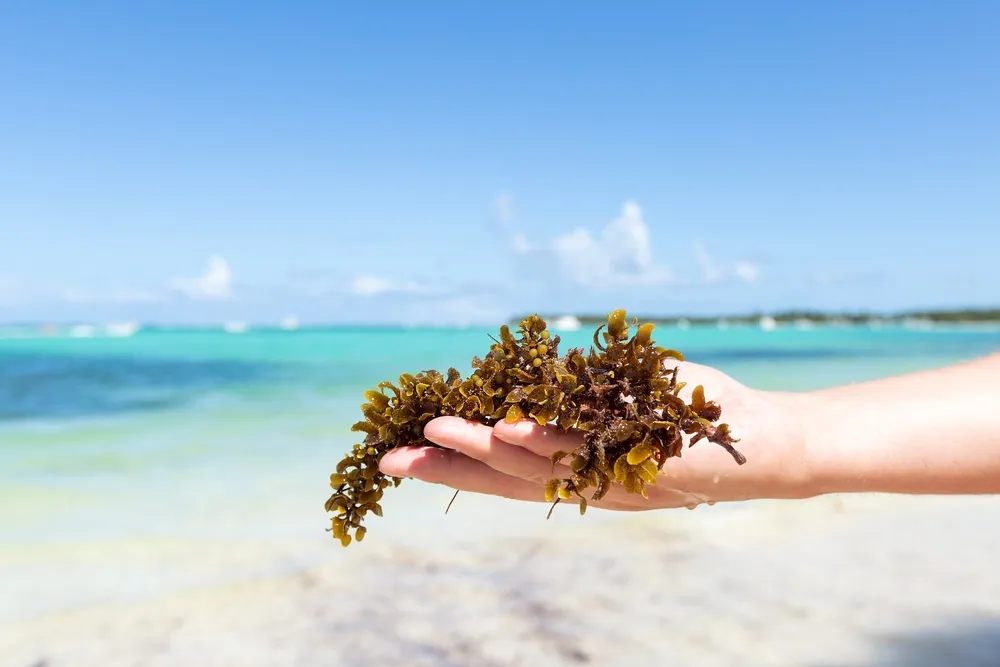Giant Toxic Seaweed "Blob" Expected to Hit the U.S.—How It Could Ruin Your Summer
An expert says evidence "doesn't bode well" for beachgoers in the upcoming warmer months.

Once the warm weather of summer returns, many people make the shore their go-to destination for weekend relaxation or vacation fun. So long as the skies remain clear and the waves stay relatively calm, there's practically nothing that can keep someone away from a good beach day. But just like any other place in nature, the ocean can be unpredictable. And now, scientists are warning that a giant "blob" of seaweed is expected to hit the U.S. in the coming weeks as it makes its way ashore. Read on to see how this natural event could ruin your favorite summer pastime.
READ THIS NEXT: If You've Done This, Don't Go in the Ocean, Doctors Warn—And It's Not Eating.
A large seaweed bloom is expected to hit the U.S. in the coming weeks, threatening summer beach days.

Usually, a day at the beach can only be ruined by getting sand in your snacks or suddenly realizing you've developed a sunburn. But this year, beachgoers may also be contending with a different type of coastal conundrum as a gigantic blob of toxic seaweed known as sargassum is expected to land on shores in the U.S. over the upcoming summer, The New York Times reports.
Experts say that the gigantic floating mass is expected to make landfall across Florida and on beaches along the Gulf of Mexico. "It's incredible," Brian LaPointe, a research professor at Florida Atlantic University's Harbor Branch Oceanographic Institute, told NBC News. "What we're seeing in the satellite imagery does not bode well for a clean beach year."
The annual event is growing in size and has become more of an issue for coastal areas lately.

Anyone who's been to a beach knows that it's not uncommon to see clumps of sea vegetation dotting the sand and floating around in the waves. But scientists say the annual growth of sargassum is becoming much more challenging to deal with as it expands both in its season and volume. Beaches in Key West, Florida, are already covered with the brown clumps months before it's typically first spotted in May, NBC News reports.
"These blooms are getting bigger and bigger, and this year looks like it's going to be the biggest year yet on record," Lapointe told The Times. "This is quite early to see this much, this soon," he said, pointing out that recent measurements show January growth is the largest ever recorded.
RELATED: For more up-to-date information, sign up for our daily newsletter.
The seaweed surge can ruin the beach experience—and even cause health problems.

Even if swimmers are prepared to occasionally contend with unusually large clumps of seaweed, local officials in certain areas have already said the problem practically ruined previous years.
"Our beach could literally be clean at 8 a.m., and three to four hours later, a giant mat of sargassum the size of a mall will come in like the blob, like a Stephen King movie," Tom Mahady, ocean rescue chief for the city of Boynton Beach, Florida, told The Palm Beach Post. "It's not pleasant for swimmers."
Others noted the clumps have taken over the beach in huge mounds. "We had moguls of it," Bobbie Lindsay, town councilmember in Palm Beach, Florida, told The Palm Beach Post about one recent seaweed surge. "The beach was unusable for much of the summer, it was scratching your thighs, it was just disgusting."
And it's not just unsightly and unpleasant to touch. Rotting sargassum on beaches releases hydrogen sulfide gas into the air, which can often cause respiratory issues for beachgoers and nearby residents, NBC News reports. LaPointe told the outlet that large seaweed blooms in 2018 had sent "thousands of people" on the Caribbean islands of Guadeloupe and Martinique to health clinics due to breathing complications caused by the conditions.
Some popular beach destinations are already planning on how to deal with the problem.

Besides its effects on tourism industries, the glut of seaweed will often also become a significant problem for local infrastructure. Floating clumps of sargassum can become a problem for boaters as it clogs local canals and marinas, snarling in propellers and making some areas impassable, NBC News reports.
Delicate ecosystems are also affected by the sudden surge of sargassum. Clumps of rotting seaweed can deplete oxygen levels in the water, endangering animal and plant life in areas like mangrove habitats, The Times reports. And large piles of seaweed on the beach can make it harder for baby sea turtle hatchlings to make their way to the water fast enough to survive, per The Palm Beach Post.
While many affected beaches have opted to rake and bury or remove the excess seaweed, sea turtle nesting can complicate the process as the machines must avoid sensitive areas above the high tide line. LaPointe has also suggested using floating barriers as a proactive way to block the bloom from reaching beaches, which has already been put into place in some areas in the Florida Keys, The Palm Beach Post reports.
However, some officials simply see the growing problem as another force of nature you can't control. "People don't like it because it's unsightly," Mahady told The Palm Beach Post. "But you can't stop it from raining, you can't stop snow, and you can't stop seaweed."





















